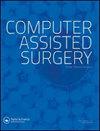一种基于Hessian板滤波和形状特征的三维超声数据NT VOI自动定位方法
IF 1.9
4区 医学
Q3 SURGERY
引用次数: 2
摘要
摘要颈半透明厚度(NT)是妊娠早期产前筛查中最重要的检测参数之一。提出了一种三维超声数据中NT感兴趣体积(VOI)的自动定位方法。该方法以胎儿头部的大小和位置以及三维超声数据中的矢状面方程为先验知识,分为三步。首先,提出了一种基于hessian的平板滤波器来增强体积中可能存在的平板。其次,选取滤波响应较大的几个voi作为候选voi;根据矢状面的先验知识对由多个连通平面组成的VOIs进行分割。第三,提出了一组形状特征,以最大概率选择NT VOI。使用我们之前提出的方法可以实现自动胎头定位和矢状面检测,这意味着使用我们的方法可以实现全自动NT体积检测。该方法以人工选择为地面真值,定位精度为86.36%。本文章由计算机程序翻译,如有差异,请以英文原文为准。
A Hessian plate filter and shape feature-based approach to automatically localizing the NT VOI of 3D ultrasound data
Abstract The thickness of nuchal translucency (NT) is one of the most important parameters to be detected in prenatal screening during the first trimester of pregnancy. In this paper, an automatic method is proposed for the localization of the volume of interest (VOI) of NT in three-dimensional (3D) ultrasound data. With the size and position of the fetal head and the equation of the sagittal plane in the 3D ultrasound data as the prior knowledge, the method can be divided into three steps. First, a Hessian-based plate filter is proposed to enhance the possible plates in the volume. Second, several VOIs with large filter responses are selected as candidates. Those VOIs consisting of several connected planes are segmented according to the prior knowledge of the sagittal plane. Third, a set of shape features is proposed to select the NT VOI with the maximum probability. Automatic fetal head localization and sagittal plane detection can be achieved using our previously proposed methodology, which means fully automatic NT volume detection could be reached by using our method. The proposed method produces 86.36% localization accuracy with the manual selection as the ground truth.
求助全文
通过发布文献求助,成功后即可免费获取论文全文。
去求助
来源期刊

Computer Assisted Surgery
Medicine-Surgery
CiteScore
2.30
自引率
0.00%
发文量
13
审稿时长
10 weeks
期刊介绍:
omputer Assisted Surgery aims to improve patient care by advancing the utilization of computers during treatment; to evaluate the benefits and risks associated with the integration of advanced digital technologies into surgical practice; to disseminate clinical and basic research relevant to stereotactic surgery, minimal access surgery, endoscopy, and surgical robotics; to encourage interdisciplinary collaboration between engineers and physicians in developing new concepts and applications; to educate clinicians about the principles and techniques of computer assisted surgery and therapeutics; and to serve the international scientific community as a medium for the transfer of new information relating to theory, research, and practice in biomedical imaging and the surgical specialties.
The scope of Computer Assisted Surgery encompasses all fields within surgery, as well as biomedical imaging and instrumentation, and digital technology employed as an adjunct to imaging in diagnosis, therapeutics, and surgery. Topics featured include frameless as well as conventional stereotactic procedures, surgery guided by intraoperative ultrasound or magnetic resonance imaging, image guided focused irradiation, robotic surgery, and any therapeutic interventions performed with the use of digital imaging technology.
 求助内容:
求助内容: 应助结果提醒方式:
应助结果提醒方式:


